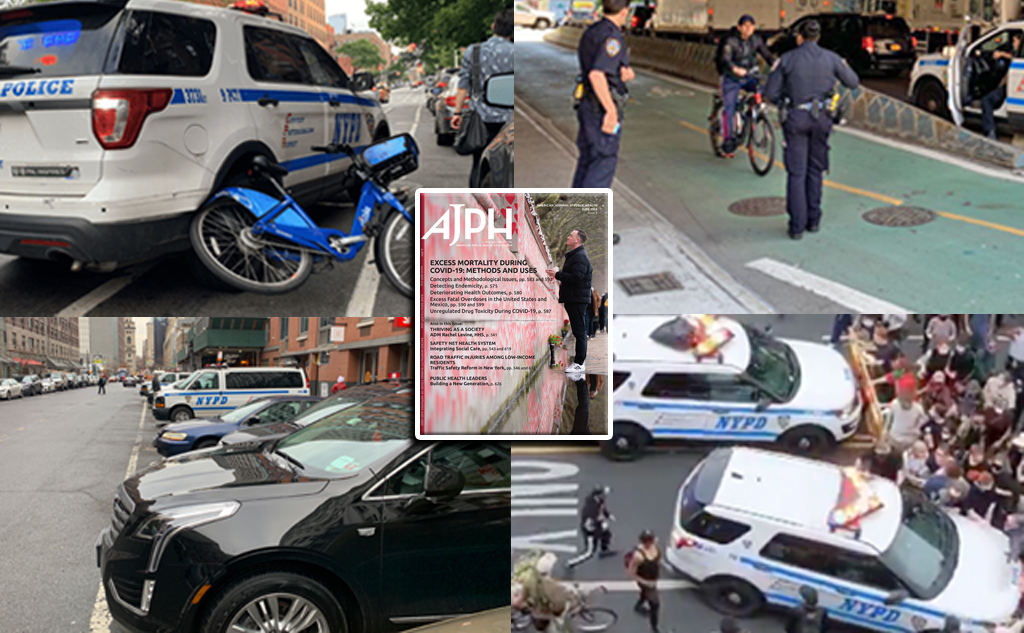The NYPD is no "Vision Zero partner."
The city's road safety initiative launch in 2014 led to pronounced reductions in traffic injuries in New York City compared to its suburbs — a decrease that was most pronounced in communities of color — but the safety trend switched dramatically during the Covid-19 pandemic in part due to a massive decline in NYPD traffic enforcement, a new study reveals.
Vision Zero reduced crashes by a rate of 77.5 per 100,000 people compared to the non-Vision Zero trendline — saving Medicaid roughly $90.8 million between 2014 and 2018. But the positive trend in the city reversed during the pandemic — when the city and its car-dependent suburbs resumed their more or less aligned pre-Vision Zero traffic injury rates, according to researchers Kacie Dragon and Sherry Giled, who published their findings in the American Journal of Public Health.
Dragon and Giled believe that the drop in Vision Zero's effectiveness in the city was partly the result of a dramatic decline in NYPD commitment to the cause of road safety. Before the pandemic, NYPD officers gave out 9,771 more tickets per month than suburban cops, but during the pandemic, city cops suddenly gave out 9,715 fewer tickets per month than their suburban counterparts (the data is for 2009 to 2021).

And the NYPD's well-documented decline in enforcement came at exactly the worst time, as reckless driving soared during the pandemic.
"Despite this [recklessness], the NYPD issued traffic violations at a lower rate than usual in 2020 and 2021," the report stated. "Using ticketing data, we found a 25-percent greater reduction in traffic ticketing during the pandemic in New York City relative to the suburbs. This is also consistent with prior research suggesting that speed limit reductions and traffic enforcement may be particularly critical pieces of Vision Zero."
The Department of Transportation frequently refers to the NYPD as its "Vision Zero partners."
The decrease in effectiveness of Vision Zero during the pandemic fell hardest on low income people of color, the report added.
"Low-income Black Americans [are] especially likely to live in high-crash areas, with roadways conducive to crashes," the report said. "In the first six years of Vision Zero, the rate of traffic-related injuries among low-income New Yorkers, and low-income Black New Yorkers in particular, fell relative to trends in surrounding counties. Given that low-income and Black Americans are more likely to live and work in places with unsafe roadways and face injuries, these findings suggest that Vision Zero-style reforms are promising for reducing disparities.
When it has strong support from the NYPD, that is. And that support continues to wane. In 2023, the NYPD wrote just 689,960 moving violation summonses, down 35 percent from the 1,062,504 summonses officers wrote in 2014, the first year of Vision Zero.
Human enforcement is a critical part of Vision Zero because tickets issued by cameras — and the city issues millions of them per year — do not count against a driver's record, meaning that the most reckless drivers can continue to endanger their neighbors without any consequence if they keep paying the $50 tickets. But just three moving violations issued by a police officer could lead to a license suspension, based on points.
On the plus side, the financial savings to our Medicaid is not insignificant. Without Vision Zero, crash injuries would have cost the health care system $762 million over the five years of 2014 to 2018. But those costs ended up being $671 million thanks to Vision Zero, a decline of 12 percent, but still evidence of how far the city needs to go to get to zero.
Police officials declined to comment or even respond to an email about this study. We will update this story if they do.






